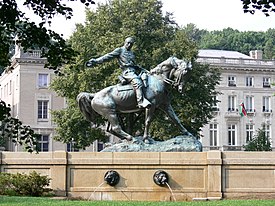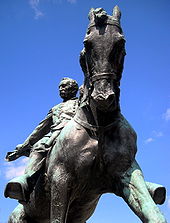Equestrian statue of Philip Sheridan (Washington, D.C.)
 | |
 | |
| 38°54′43.8″N 77°03′02.4″W / 38.912167°N 77.050667°W | |
Equestrian statue of Philip Sheridan | |
| Part of | Civil War Monuments in Washington, D.C. |
|---|---|
| NRHP reference No. | 78000257[1] |
| Added to NRHP | September 20, 1978[2] |
| Location | Sheridan Circle, Washington, D.C., United States |
| Designer | Gutzon Borglum (sculptor) Henry Winslow (architect) |
| Material | Bronze (sculpture) Granite (base) |
| Length | 12 feet (3.7 m) |
| Width | 5 feet (1.5 m) |
| Height | 10 feet (3.0 m) |
| Opening date | November 25, 1908 |
| Dedicated to | Philip Sheridan |
General Philip Sheridan is a
History
Background
On March 2, 1889, Congress authorized the erection of a memorial to Sheridan and appropriated $50,000 for its construction.

On January 17, 1908, Borglum's design received approval by the Sheridan monument commission, including then-Secretary of War William Howard Taft, General Henry C. Corbin, and Brigadier General Michael V. Sheridan, Philip Sheridan's brother. Irene also approved the design and chose the memorial site.[9][10]

She lived at 2211 Massachusetts Avenue NW (currently offices for the Embassy of Greece), a short distance from Sheridan Circle and the sculpture.[11] As Borglum worked on the sculpture, he would talk to Sheridan's friends, sketch Sheridan's artifacts, and visit Irene. Since Philip Jr. bore a very close resemblance to his father, Borglum used him as a model for the sculpture. When the artwork was completed, Irene, Philip Jr., and Sheridan's three daughters loved the finished result.[3] The sculpture depicts Sheridan riding his horse, Rienzi, as he assembles his troops during the Battle of Cedar Creek on October 19, 1864. He had raced 20 miles (32 km) from Winchester, Virginia, to reach the battle. Following the Union victory, Sheridan renamed the horse Winchester. After Winchester died in 1878, Sheridan had him preserved and mounted. The horse is now on display at the National Museum of American History.[12] Congress paid for the plaza, base, and preparation of the memorial site, while veterans of the Army of the Cumberland paid for the statue.[13] Architect Henry Winslow designed the base and setting. The stonework was provided by the Mohegan Granite Company of New York while the Malnati Stone Company of Washington, D.C. set the stones in place.[4]
Dedication
The Sheridan memorial was dedicated on November 25, 1908. A large crowd was present with many dignitaries in attendance, including President
Historic designation
Along with
Design and location

The bronze equestrian sculpture is at the center of Sheridan Circle, a traffic circle located at the intersection of 23rd Street, R Street and Massachusetts Avenue NW within the
Inscriptions on the monument include the following:[4]
- GUTZON BORGLUM 1908 (left side of the sculpture)
- GORHAM CO FOUNDERS (right side of the sculpture near the base)
- SHERIDAN (front side of the base)
See also
- List of equestrian statues in the United States
- List of public art in Washington, D.C., Ward 2
- Outdoor sculpture in Washington, D.C.
References
- ^ "National Register Information System". National Register of Historic Places. National Park Service. July 9, 2010.
- ^ a b c "District of Columbia Inventory of Historic Sites" (PDF). District of Columbia Office of Planning – Historic Preservation Office. September 30, 2009. Archived from the original (PDF) on November 5, 2014. Retrieved November 11, 2014.
- ^ ISBN 9780801858611. Retrieved November 11, 2014.
- ^ a b c d e f g "General Philip Sheridan, (sculpture)". Smithsonian American Art Museum. Archived from the original on November 7, 2014. Retrieved November 11, 2014.
- from the original on April 1, 2018. Retrieved November 11, 2014.
- ^ Richard, Paul (July 3, 2005). "From the Collection: Washington's Prize Possessions". The Washington Post. Archived from the original on November 12, 2014. Retrieved November 11, 2014.
- ^ Longaker, Mark (May 23, 2007). "Men on horseback dominate memorials". The Washington Times. Archived from the original on November 20, 2014. Retrieved November 11, 2014.
- ^ "Borglum, Gutzon, 1867–1941, sculptor". Smithsonian American Art Museum. Archived from the original on November 12, 2014. Retrieved November 11, 2014.
- ^ "Phil Sheridan Statue: Monument of the Cavalry Leader for the Nation's Capital". New-York Tribune. January 26, 1908. Archived from the original on November 12, 2014. Retrieved November 11, 2014.
- ^ "National Register of Historic Places Registration Form". National Park Service. p. 9. Retrieved November 11, 2014.
- ^ "The Building". Embassy of Greece in Washington, D.C. Archived from the original on November 12, 2014. Retrieved November 11, 2014.
- ^ Modany, Angela (April 4, 2012). "The "War Horse" of the Civil War". National Museum of American History. Archived from the original on November 12, 2014. Retrieved November 11, 2014.
- ^ Scott, Gary (September 19, 1977). "National Register of Historic Places Inventory—Nomination Form". National Park Service. p. 9. Retrieved November 11, 2014.
- OCLC 777027791.
External links
 Media related to General Philip Sheridan Memorial at Wikimedia Commons
Media related to General Philip Sheridan Memorial at Wikimedia Commons
